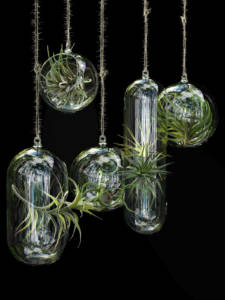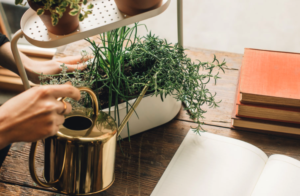Scientific research supports the positive effects of greenery in the workplace, both on the people and the environment. Plants brighten the space, improve air quality, help relieve stress, and improve the overall mood of employees, all of which results in increased productivity. Despite these stated and proven benefits, the modern business environment is not entirely conducive to plant life; note the presence of air conditioning, low light, and busy schedules. To combat these obstacles, here are a few unique plants that will do well in the lower light associated with office environments and require infrequent watering.
Low Light:
Silver Dollar Jade:
Technically a type of succulent, it is an extremely hardy Plant and only requires watering when soil is dry.
Kokedama (low maintenance):
Japanese moss balls which do not require a planter. They prefer low to medium light and require soaking once a week. Easily hung, they are unique in shape and require minimal weekday care1.
Bonsai (certain types):
While bonsai are a bit more challenging to grow, due to the pruning and initial shaping, those requiring low light are easy to care for and do well in indoor environments2.
Lucky bamboo:
This is an easy to grow plant which tolerates both low and high light. If grown in water, 2-3 inches should be refreshed every 7-10 days to start, increasing the water level as the bamboo grows. If kept in soil, it just needs to remain slightly damp and watered as needed.
Madagascar Dragon Tree:
only requires misting once a week.
Hawaiian Umbrella:
can live in dim lighting and low humidity. However, it does require potting every second year in the springtime.
High Light:
Succulents:
Super easy to care for, these are highly popular desk plants that only need to be watered once a week at maximum, or when dry.
Air Plants:
Only require rinsing every 2-3 weeks.
English Ivy:
Not only beautiful and classic in appearance, but the English Ivy is an excellent air purifier.
Pothos:
Another durable trailing plant, it does best in bright and indirect light and does not require watering any more than one to two weeks, or when the soil is completely dry. Its cousin, Scindapsus, has three popular varieties: Silvery Anne, Argyraeus, and Exotica. Example: This is how the Planteria Group used Scindapsus as a statement piece with M Moser Associates for a London Client3.
Herb Garden:
An easy way to spruce up a breakroom or kitchen, a mini herb garden freshens the air and can be used to garnish a lunch or make some tea. The best herbs for in-office use are those that require less light. Herbs such as arugula, bay laurel, chives, cilantro, lemon balm, lemon verbena, mint, oregano, parsley, rosemary, sage, tarragon, and thyme make the cut4.
These plants are easy to incorporate into spatial design through built-in planters, green walls, as decoration on the tops of pillars, in hanging planters, or as a small accent that can be placed on any flat surface, be it a conference table or individual desks.
In fact, the presence of a mere desk plant has a positive effect on the stress levels of those who have access to greenery [table 1]5. The participants of this study selected their own desk plants and prescribed “gazing time” throughout the day. The participants had their pulse rate and State-Trait Anxiety Inventory [STAI] examined before and after exposure to plants. Seventeen of the participants experienced a significant decrease in pulse rate, whereas nine experienced a significant increase, and 37 showed no significant change6. However, those that did enjoy the presence of the plants of their desk, professed positive psychological benefits [table 2]. Even without a green re-vamp, simply having a small plant in the corner of a desk can make a difference.
For additional studies on the proven benefits of plants, visit ciphr.
If plants remain inviable, then simply adding green or natural elements to the space can provide a similar effect as a nod to nature, and proof of the studies which correlate increased calm and focus and the color green. For a more in-depth look into this psychological effect check out this link:
~ ~ ~ ~ ~ ~ ~ ~ ~ ~ ~ ~ ~ ~ ~ ~ ~ ~ ~ ~ ~ ~ ~ ~ ~ ~ ~ ~ ~ ~ ~ ~ ~ ~ ~ ~ ~ ~ ~
- Kristi Kellog, “31 Best Low-Light Indoor Plants and How to Care for Them,” Architectural Digest, May 18, 2020, https://www.architecturaldigest.com/gallery/best-low-light-indoor-plants.
- Renzo Del Castillo, “Bonsai Trees that Grow Under Low Light, Bonsaitreegardener, May3, 2019, https://www.bonsaitreegardener.net/bonsai-trees/under-low-light
- “M.Moser Associates,” Case Studies, Planteria Group, https://www.planteriagroup.com/case-studies/m-moser-associates-case-study-london-client.
- Tassy de Give, “DIY Desktop Herb Garded to Help You Zen Out While You Work: Learn How to plant and grow and indoor edible garden on your desk with this step-by-step how-to guide,” Plant your Plate, Healthy Eating 101, EatingWell, https://www.eatingwell.com/article/290777/diy-desktop-herb-garden-to-help-you-zen-out-at-work/.
- Masahiro Toyoda et. al., “Potential of a Small Indoor Plant on the Desk for Reducing Office Worker’s Stress,” American Society for Horticultural Science, 30, no. 1 (December 2019): 55-63, https://doi.org/10.21273/HORTTECH04427-19.
- Toyoda, “Potential of a Small Indoor Plant,” 59.; It should be noted that the pulse rate and STAI scores did not correspond with the same people.
————————————————————————-
Article written by Bryn Baldasaro for The Element Group.












